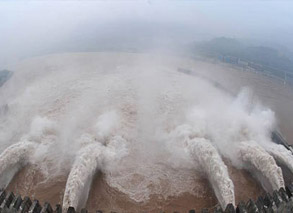Backgrounder: Key facts about A/H1N1 flu
2009-10-29 15:27 BJTSpecial Report: World tackles A/H1N1 flu |
WASHINGTON, April 25 (Xinhua) -- A new A/H1N1 flu strain has killed as many as 20 people and sickened more than 1,300 across Mexico. Eleven U.S. people were also confirmed to be infected with the virus.
The World Health Organization announced Saturday that the outbreak in Mexico and the United States constituted a "public health emergency of international concern."
The following are questions and answers about A/H1N1 flu:
What is A/H1N1 flu?
A/H1N1 flue (Influenza) is a respiratory disease of pigs caused by type A influenza viruses. Outbreaks of A/H1N1 flu happen regularly in pigs. People do not normally get A/H1N1 flu, but human infections can and do happen. Most commonly, human cases of A/H1N1 flu happen in people who are around pigs but it's possible for A/H1N1 flu viruses to spread from person to person also.
The new strain found in Mexico and the U.S. is a mixture of swine, human and avian flu viruses.
Is this new A/H1N1 flu virus contagious?
The U.S. Centers for Disease Control and Prevention (CDC) has determined that this virus is contagious and is spreading from human to human. However, at this time, it is not known how easily the virus spreads between people.
What are the signs and symptoms of A/H1N1 flu in people?
The symptoms of A/H1N1 flu in people are similar to the symptoms of regular human flu, including fever, cough, sore throat, body aches, headache, chills and fatigue. Some people have reported diarrhea and vomiting associated with A/H1N1 flu. In the past, severe illness (pneumonia and respiratory failure) and deaths have been reported in A/H1N1 flu patients. Like seasonal flu, A/H1N1 flu may cause a worsening of underlying chronic medical conditions.
How serious is A/H1N1 flu infection?
Like seasonal flu, A/H1N1 flu in humans can vary in severity from mild to severe. From 2005 until January 2009, 12 human cases of A/H1N1 flu were detected in the U.S. with no deaths occurring. However, A/H1N1 flu infection can be serious. In September 1988, a previously healthy 32-year-old pregnant woman in Wisconsin was hospitalized for pneumonia after being infected with A/H1N1 flu and died 8 days later.
How do people catch A/H1N1 flu?
Spread of A/H1N1 flu can occur in two ways: through contact with infected pigs or environments contaminated with A/H1N1 flu viruses; through contact with a person with A/H1N1 flu. Human-to-human spread of A/H1N1 flu has been documented also and is thought to occur in the same way as seasonal flu. Influenza is thought to spread mainly person-to-person through coughing or sneezing of infected people.

 Mail
Mail Share
Share Print
Print


 Video
Video









 2009 China Central Television. All Rights Reserved
2009 China Central Television. All Rights Reserved